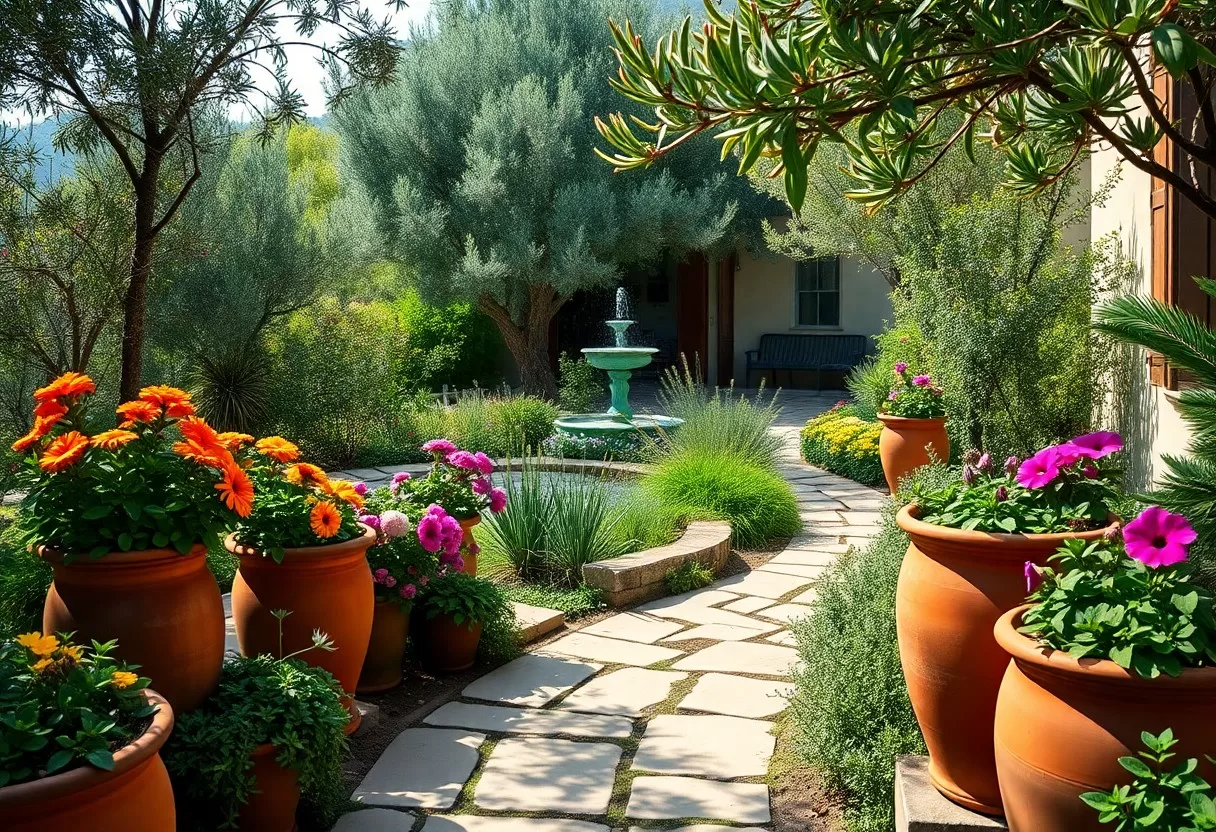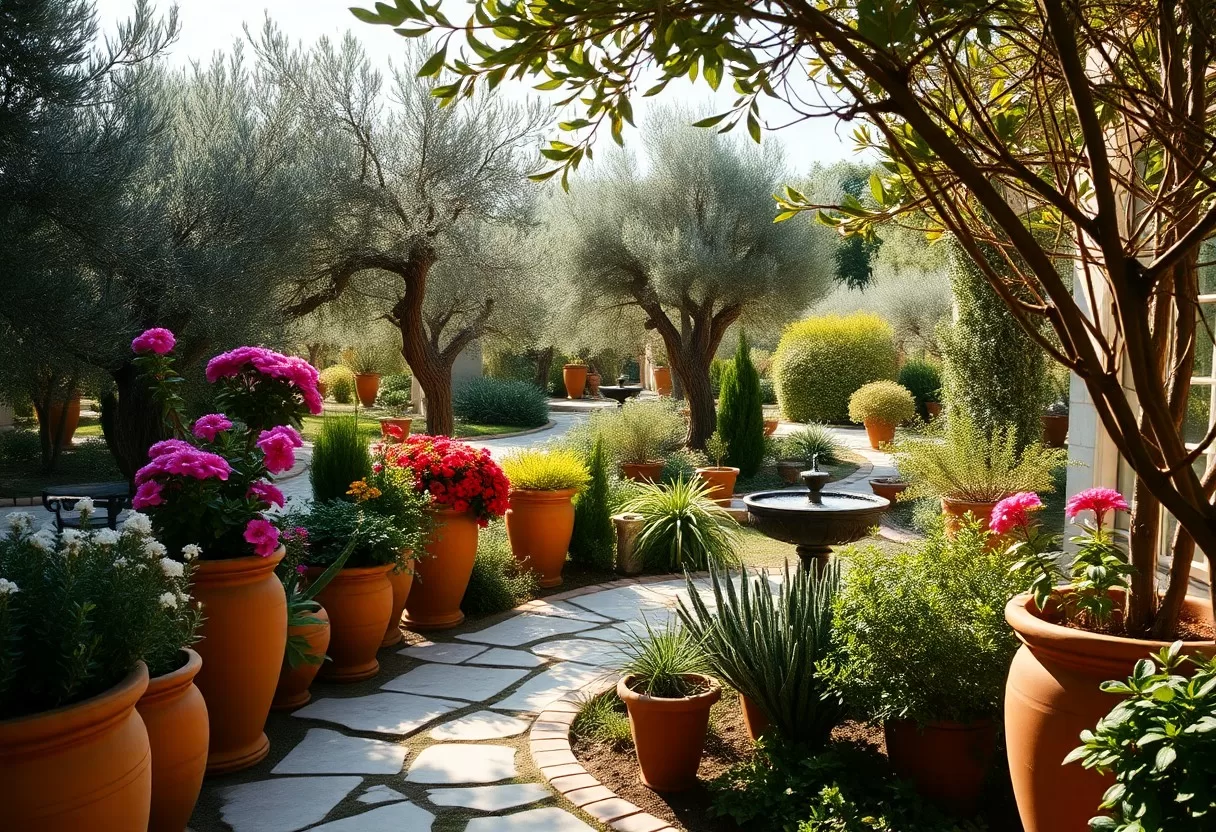Creating Serenity – How To Design Your Mediterranean Garden Retreat
Design your peaceful escape by transforming your outdoor space into a stunning Mediterranean garden retreat. Utilizing vibrant colors, fragrant plants, and inviting hardscapes, you can cultivate a serene atmosphere that feels like a luxurious getaway. From choosing the right native plants to incorporating water features for relaxation, each element plays a vital role in achieving your ideal place. For expert insights, explore this post on How to Design a Mediterranean Landscape.
Key Takeaways:
- Embrace natural elements by incorporating local stones, clay, and terracotta to create an authentic Mediterranean vibe.
- Prioritize low-maintenance plants such as lavender, rosemary, and olive trees, focusing on drought-resistant varieties to enhance sustainability.
- Design with open spaces in mind, creating inviting terraces and seating areas that promote relaxation and gatherings.
- Utilize water features, such as fountains or ponds, to foster a soothing atmosphere and attract wildlife.
- Incorporate bright colors and earthy textures through decorative tiles and textiles to add warmth and charm to your garden retreat.

Mastering Mediterranean Flora
Enhancing your Mediterranean garden retreat involves selecting the right plants that thrive in local conditions while offering low maintenance and vibrant beauty. Incorporating native flora not only creates a harmonious environment but also supports local wildlife and biodiversity. By choosing species adapted to your region, you can cultivate a flourishing landscape that captures the essence of the Mediterranean.
Selecting Native Plants to Enhance Local Soil
Opting for native plants ensures that you work with the existing soil conditions, promoting sustainable growth and reducing the need for fertilizers or excessive irrigation. Plants such as lavender, sage, and oleander are well-suited for Mediterranean climates, showcasing resilience against drought and requiring minimal upkeep.
Curating Color Palettes with Seasonal Blooms
Transform your garden into a vibrant tapestry of color by carefully selecting plants with blooms that complement each other throughout the seasons. Aim for a mix of early, mid, and late bloomers, like bougainvillea in summer and anemones in spring, ensuring a continuous display of color. This thoughtful approach provides a lively and inviting atmosphere, reinforcing the relaxation and beauty of your outdoor retreat.
Color palettes can elevate your garden’s aesthetic by blending plants with varying blooming periods, textures, and hues. For instance, juxtaposing the bright purples of lavender with the soft whites of oleander can create striking visual contrasts. Additionally, incorporating foliage plants like rosemary and thyme adds depth, ensuring there’s always something visually interesting to admire, regardless of the time of year. This careful curation not only keeps the garden looking its best but also generates a lively atmosphere that enhances your relaxation space.
Designing Tranquil Spaces
Creating serene corners within your Mediterranean garden significantly enhances relaxation and peace. Start by choosing a harmonious layout that promotes fluid movement through your space, enabling you to fully immerse yourself in the natural beauty surrounding you. Use winding paths lined with native plants to lead your eye and draw you into those secluded areas, inviting you to pause and enjoy moments of solitude.
Strategic Layouts for Maximum Serenity
Arrange your garden elements thoughtfully to foster a sense of calm and cohesion. Zoning various sections, such as seating areas nestled among lush greenery, defines separate experiences within the garden. Consider the flow of sunlight and shade as you position your plants, benches, and walkways—this ensures that your tranquil spaces remain inviting throughout the day.
Integrating Water Features: Fountains and Ponds
Water features embody tranquility, introducing soothing sounds and captivating visuals into your garden. A small fountain can create a gentle background murmur, while a pond with koi fish invites dynamic life into your retreat. They become focal points that effortlessly draw your attention, enhancing the overall atmosphere of serenity.
Fountains, with their varied designs, offer more than just a beautiful aesthetic; they create a mesmerizing soundscape that promotes relaxation. Choose materials that complement your Mediterranean theme, such as terracotta or stone, and position the fountain to be visible from multiple angles. For ponds, consider incorporating aquatic plants like water lilies and goldfish, which not only add color but also contribute to a balanced ecosystem. Strategically placing seating nearby allows you to enjoy these features up close, making them an integral part of your gardening experience.

Embracing Sustainable Practices
Integrating sustainability into your Mediterranean garden not only fosters a healthy ecosystem but also reduces your carbon footprint. By adopting eco-friendly techniques, you can cultivate a vibrant retreat that thrives harmoniously with nature. Consider plant selection that requires minimal water, such as drought-resistant species and native flora, to conserve resources. Furthermore, focus on practices such as composting and organic gardening to promote biodiversity and soil enrichment, ensuring your garden remains lush without harmful chemicals.
Implementing Efficient Irrigation Systems
To maximize water efficiency in your garden, employ drip irrigation systems or soaker hoses that deliver water directly to the root zones of your plants. This method minimizes evaporation and runoff, conserving precious resources while ensuring your flora receives adequate hydration. Additionally, consider integrating rain barrels to collect runoff and utilize this free source for irrigation during dry spells.
Utilizing Mulch and Organic Matter for Soil Health
Enhancing soil quality through the use of mulch and organic matter significantly boosts the health of your garden. Organic matter, such as well-rotted compost or aged manure, enriches the soil with nutrients and improves its structure by promoting airflow and water retention. Applying mulch around your plants helps suppress weeds, regulates soil temperature, and conserves moisture, further supporting your garden’s thriving ecosystem. This sustainable practice not only fosters healthy growth but actively contributes to soil conservation and fertility.
Incorporating organic matter and mulch into your gardening routine pays dividends by enriching your soil with vital nutrients that encourage robust plant growth. For instance, a mixture of straw, wood chips, or even shredded leaves can serve as an excellent mulch layer, breaking down over time to enhance soil structure and fertility. By maintaining a steady supply of organic material, you create a richer habitat for beneficial microbes and soil life, which in turn supports healthy plant growth, making your Mediterranean garden even more resilient to environmental stressors.
Creating Inviting Focal Points
Focal points in your Mediterranean garden can transform spaces into inviting retreats. You can achieve this by incorporating bold sculptures, vibrant flowering plants, or exquisite water features. These elements draw the eye and create areas that invite exploration and contemplation, encouraging you and your guests to linger and enjoy the surroundings while enhancing the overall harmony of your garden design.
Crafting Cozy Seating Areas with Rustic Charm
Rustic charm in seating areas adds warmth and authenticity to your garden. Opt for weathered wooden benches, wrought iron chairs, or stone seating that blend seamlessly with the natural landscape. Adorn these spaces with colorful cushions and throws to enhance comfort, making them perfect spots for relaxation or deep conversations under the sun or stars.
Enhancing Pathways with Natural Materials
Pathways in your Mediterranean garden should feel organic and integrated into the landscape. Using materials such as local stone, gravel, or reclaimed wood not only enhances the visual appeal, but also promotes a sense of harmony with nature. Incorporate meandering paths that encourage exploration, with plants or low hedges flanking the sides to create a sense of enclosure and intimacy within the garden. Consider adding stepping stones or mosaic tiles to further personalize the pathways, allowing them to serve as functional art pieces that guide visitors through your serene retreat.
Cultivating an Atmosphere of Relaxation
Achieving a tranquil ambiance in your Mediterranean garden retreat involves thoughtful choices that encourage calm and unwinding. Begin with seating arrangements that invite you to linger, such as inviting loungers under the shade of a pergola or a cozy nook draped with soft textiles. Enhance the experience by integrating soothing features like a water fountain or gently swaying hammocks—elements that promote serenity. Finally, create an intimate space where you can escape daily stressors and indulge in the pure pleasure of nature.
Selecting Ambient Lighting for Evening Enjoyment
Opt for soft, ambient lighting to create an inviting evening glow in your garden. String lights hung delicately above seating areas or lanterns placed strategically along paths offer both safety and charm. Consider low-voltage LED fixtures to illuminate focal points like a charming statue or an enticing plant bed while ensuring a relaxing atmosphere. Finally, candles and fire pits provide both warmth and a flickering light that draws you in, enhancing the feeling of tranquility as the sun sets.
Incorporating Aromatic Herbs and Fragrant Flowers
Infusing your Mediterranean garden with aromatic herbs and fragrant flowers adds a sensory layer that elevates the entire experience. Scents of rosemary, lavender, and thyme can be planted in raised beds or pots, enhancing the garden both visually and olfactorily, while also proving beneficial for cooking and relaxation. Consider arranging fragrant blooms like jasmine and gardenias near seating areas to create a refreshing scent that drifts gently in the air. Such elements not only attract beneficial pollinators but also evoke feelings of nostalgia and serenity, making your retreat even more inviting.
Aromatic herbs like basil and mint are ideal candidates for pots placed throughout your garden—within arm’s reach for those moments when you want to crush a leaf and release its aroma. Flowering plants such as honeysuckle and lavender not only fill the air with delightful scents but can also bloom at different times throughout the seasons ensuring that your garden remains a haven for your senses year-round. By strategically selecting and placing these fragrant companions, you weave a tapestry of smells that enhance the overall relaxation you seek in your garden sanctuary.
Conclusion
Considering all points, creating your Mediterranean garden retreat is an exciting opportunity to enhance your outdoor space. By selecting the right plants, incorporating rustic materials, and designing inviting seating areas, you can cultivate an atmosphere of relaxation and tranquility. Don’t hesitate to explore more resources, like How to Design a Mediterranean Outdoor, to further inspire your design journey. Your Mediterranean oasis awaits, ready to be a sanctuary for both you and your loved ones.
